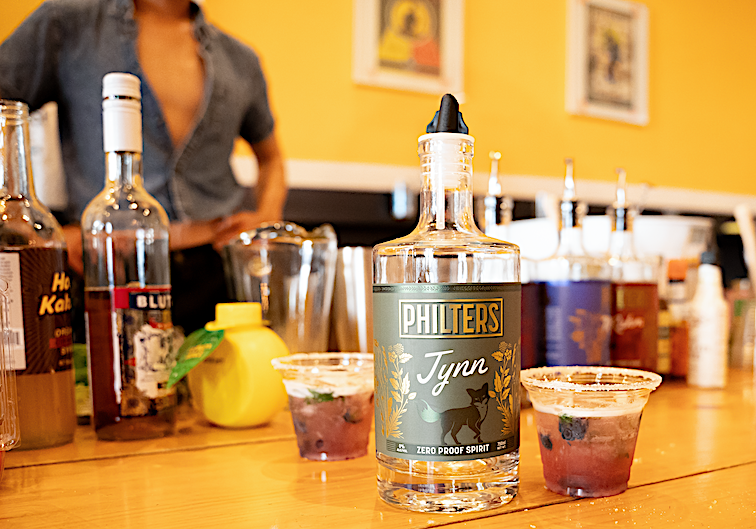
Philters Distilling produces four nonalcoholic spirits that are creatively spelled Whiski, Ruhm, Jynn, and Mezkahl. The zero-proof spirits are flavored with oak chips, chicory, coriander, lemon verbena, lapsang souchong, cinnamon, ginger, and clove. Photo courtesy of Philters
By Teresa Bergen
Rows of glass jars stand on shelves on the back wall of the Wilderton distillery in Hood River, Oregon. “You’re more than welcome to take the lids off and sniff any of the herbs and botanicals,” says Isabella Hanreiter, tasting room associate and our tour guide. My husband and I open jars and smell mace, clove, patchouli, wormwood and smoky teas. The scents range from delicious to familiar to odd. Hanreiter tells us that the strange contraption on the table is a miniature still. This is the onsite workshop of Wilderton’s distiller and co-founder Seth O’Malley. However, he later admits that, in true mad scientist form, even more of his work happens in his home basement lab.
Wilderton is one of many companies around the world creating the burgeoning class of non-alcoholic spirits. As liquor sales have fallen in recent years, non-alcoholic variants are on the rise. From January to July 2024, traditional spirits fell 3% in the US, while non-alcoholic varieties went up 29% compared to the first seven months of 2023. Indeed, over the past year, U.S. sales of nonalcoholic spirits increased 26% to a total value of $800 million. Some experts predict this sector could be worth $271 billion by 2033.
Alcohol-loving skeptics might be asking what is this stuff, who drinks it and what does it taste like. Here’s the lowdown.
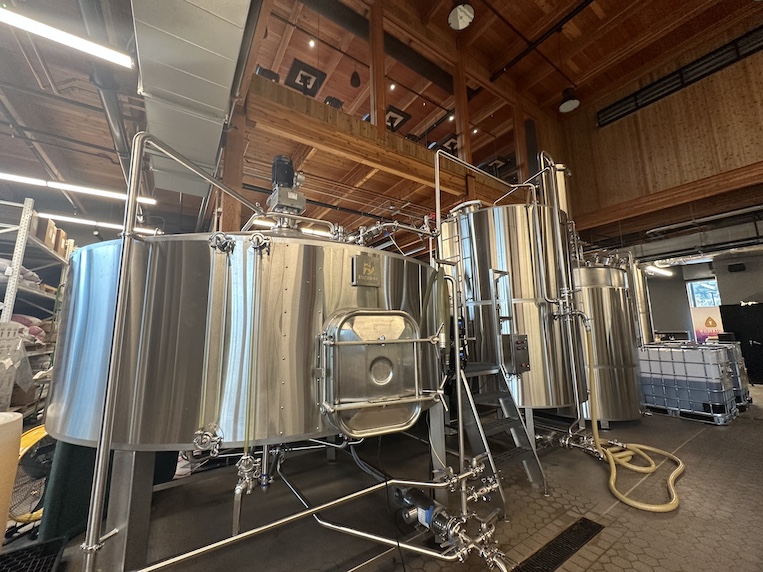
The Wilderton Distillery in Hood River Oregon looks like a conventional maker of whiskey. But look inside the tanks and you’ll encounter smells associated with mace, wormwood, and herbal tea. Photo by Teresa Bergen
Why Drink Fake Alcohol?
You might assume that consumers of faux spirits are people who quit drinking the real stuff. But that’s only a small minority of the market. O’Malley estimates that perhaps a quarter of the people who visit the Wilderton tasting room identify as ‘in recovery’. “A lot more people are in this sort of in-between camp,” he says. They might be participating in Dry January, Sober October, or dryish January. “The reason that we’re doing this is just to give people who want to have nonalcoholic versions of great cocktails the tools to do so. Because historically these people have not been served with great options. It’s a new category.”
Between Gen Z drinking less than their forebears and people of all ages concerned about their health, the idea of a delicious cocktail without consequences appeals to many. Marten Lodewijks, president of global drinks data provider IWSR US, attributed the decline in traditional spirit sales in part to greater consumer awareness of health and wellness. “While this trend skews more towards younger consumers, it’s by no means restricted to them and it is seen across the generations to varying degrees,” he told the Spirits Business website.
Indeed, some dire warnings have come out recently. We already knew our livers were in danger. But now the World Health Organization has claimed there is no safe level of alcohol consumption. In the first week of 2025, U.S. Surgeon General Dr. Vivek Murthy released a statement that drinking alcohol is the third major preventable cancer risk after smoking and obesity.
Parity vs. Innovation
Nonalcoholic spirit makers take two approaches to their products: trying to replicate the experience of drinking traditional spirits or coming up with something new.
British company Seedlip entered this market early, launching its innovative botanical drinks from a farm in The Chilterns in 2015. Founder Ben Branson drew on recipes published in 1651 by physician John French. Using a copper still, Branson began experimenting with herbs from his garden. Seedlip’s flagship flavors include Grove 42, made from citrus and ginger, and Spice 94, tasting of cardamom and allspice. Garden 108 combines herbs with English peas. Since 2019, multinational alcohol company Diageo has been Seedlip’s majority owner, and you can find these calorie-free botanicals behind bars around the world.
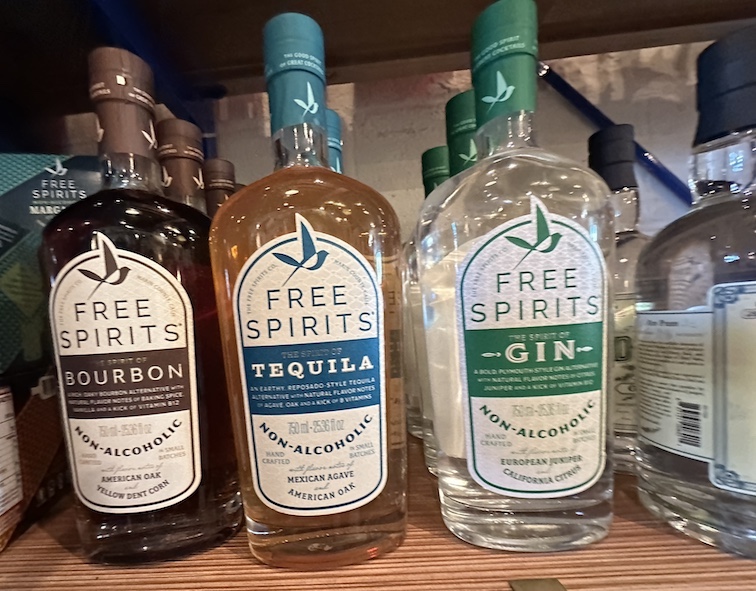
According to a recent Gallup Poll, not all Americans ordering zero-proof mocktails are teetotalers. A growing number of adults out for a night on the town flirt with sobriety by alternating alcoholic and nonalcoholic drinks. Photo by Teresa Bergen
Other companies, like Philters, make alcohol-free drinks that mimic standard spirits. With names like Ruhm, Jynn, Wiski and Mezkahl, it’s obvious what flavors Philters is going for. Manish Shah, founder and CEO of Maya Tea, used his extensive tea background to create Philters, which launched in October 2024. “This was the hardest project I’ve ever worked on,” he said. “It took us five years.” An analog requires three things, Shah said: flavor, function and feeling. “From a functional standpoint, do I have to change how I use it as compared to its origin?” he asked. “So, is it shot for shot? Can a mixologist use it pretty easily? Do they have to change the rules for how they make the drinks?”
O’Malley also comes from a tea background. Whether creating an analog or an innovative nonalcoholic product, he pondered what is special about spirits. “There’s an intensity to them,” he said. “Every spirit consumed neat at least kind of overwhelms the palate in a way that’s exciting and fun.”
Shah wants his drinks to lift people’s moods, so he adds nootropics and adaptogens. Nootropics are natural and synthetic ingredients that claim to boost brain function by improving attention, focus and memory. Adaptogens are plant ingredients found in certain herbs and mushrooms that help the body deal with stress, anxiety and fatigue. Philters adds nootropics to its Jynn and Mezkahl to boost energy. Ruhm and Wiski get an adaptogen dose of ashwagandha, tulsi, Siberian ginseng, and passionflower to promote a soothing sense of well-being.
This focus on nonalcoholic drinks is a worldwide movement. In India, a company called Sober is making the country’s first zero-proof spirits, including its takes on whiskey, rum and gin. In Brisbane, Australia, the Nonalcoholic Club website introduces customers to Australian-made alcohol-free beverages. And even the French are embracing non-alcoholic wine.
Processes For Making Zero-Proof Alcohol
To make a nonalcoholic spirit, producers either prevent alcohol from forming by halting the fermentation process at an early stage, or they remove the alcohol after distillation.
At Wilderton, Hanreiter showed us how bittersweet aperitivo is made using a water-based process. “Everything starts here in our lauter tun,” she told us, indicating a big silver vessel with a ladder on the side. “This is where we put all of our raw ingredients, all the raw botanicals. Kind of acts as our giant teapot.” After steeping, the concoction moves to a blending tank, where workers stir in chardonnay grape juice, cold citrus oil and purple ube potatoes, which gives the drink its red color. “We’re trying to build a bold flavor in these mixing tanks,” she said. “And so, after it sits for about a week, that’s when we’ll end up bottling it.”
Philters also uses a water-based process, crafting small batches in 100 and 200-gallon kettles at its Tucson, Arizona factory. Shah didn’t want to give away too many details of his proprietary process but said it included steeping herbs, spices, and adaptogens, then putting the brew through a series of filters to smooth the flavors out. “We’ve got this sort of master formula that involves time, temperature, ingredients, filtration, and bottling technique,” he said.
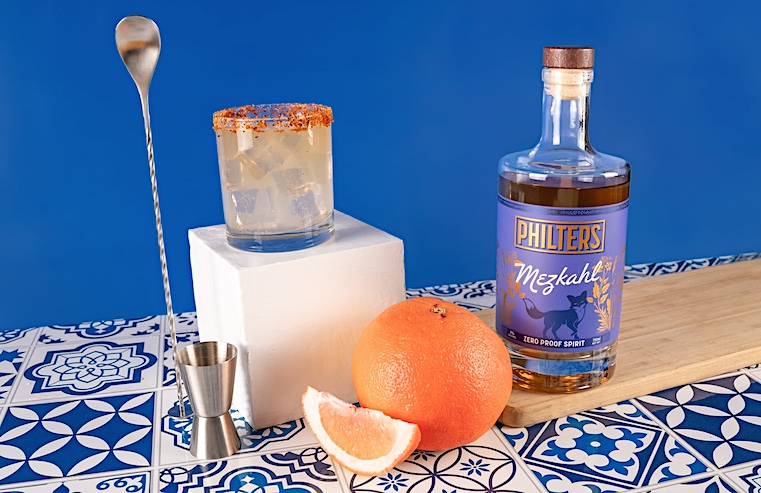
Try nonalcoholic Mezkahl in your next margarita. Your only health concern will be the amount of salt the bartender puts on the rim of the glass. Photo courtesy of Philters
Other manufacturers use a method called fractional distillation to remove alcohol from the spirit after it’s already been distilled. This leads to a finished product that tastes very similar to a traditional alcoholic spirit.
The spinning cone method is one type of fractional distillation used in removing alcohol from wine and spirits. As leading manufacturer BevZero describes in this video about de-alcoholizing wine, inside its column of spinning cones are about 40 upside-down cones, half of which are fixed and half of which spin. The spinning cones spin the wine out into thin liquid films. Meanwhile, a cool vapor rises from the wine itself, rising and carrying off the lightest molecules. Ultimately this process divides the wine into aroma flavor, alcohol and body.
Philters and Wilderton use water-based methods that involve no alcohol and can be sold as “zero-proof.” Manufacturers that de-alcoholize spirits wind up with what’s termed “nonalcoholic” by law but can include up to 0.5% alcohol by volume. While you would have to drink a large amount to feel any effect, people who are very sensitive to alcohol will want to drink only zero-proof spirits.
Learning From Perfumery
O’Malley’s tea background informed him on which botanicals work best with a water base. But he also researched perfumery to develop nonalcoholic spirits. “Just about anything that we’d use in a botanical spirit has been also used by perfumers to make fragrances,” he said. “Flavor and fragrance have always been intertwined and historically were a lot more intertwined than they are today, where we often think about them separately.”
He was especially interested in learning about the tenacity of botanicals. “So, if something is a base note in a perfume, if it lasts on the skin for a long time, that also tells you something about the way you’ll taste it. It tells you that it also will last on the palate for a long time.” By delving into perfumery literature, he got ideas about which flavor molecules would remain longer on the tongue and in the throat. “I notice that when it comes to nonalcoholic beverages generally, something that characterizes most of them is that they don’t last very long, that they don’t have much of an aftertaste or much structure. And that’s what makes them feel kind of unserious most of the time. So that was an important priority to me.”
Zero-Proof Brands Go Upscale and Win Awards
Understanding and appreciation of nonalcoholic drinks has come a long way in the last few years. When Chris Marshall opened Austin’s alcohol-free Sans Bar in 2017, “The response at first was tepid, to put it nicely. There were a lot of people who just did not understand what I was trying to do,” he said. “So, we got a lot of pushback from the public. Someone said, ‘What’s next, a restaurant that doesn’t serve food?’”
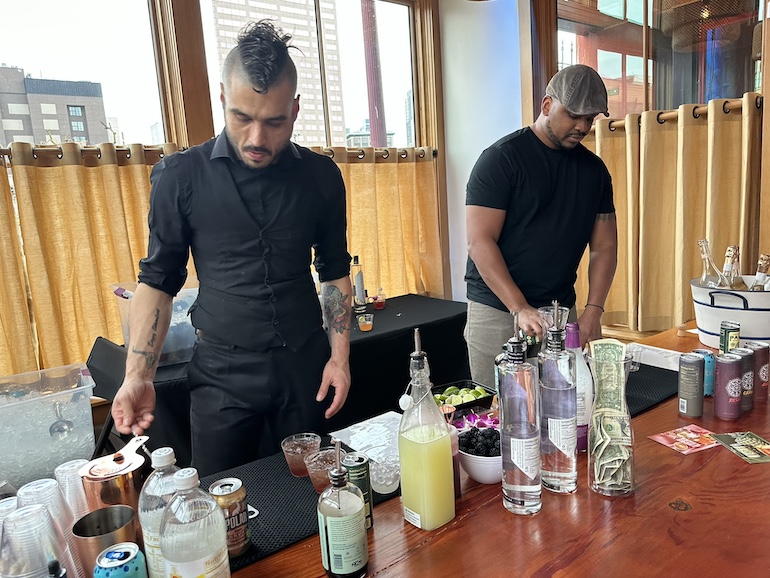
Two Sans Bar mixologists show how to make award-winning mocktails. Photo by Teresa Bergen
Fewer people are laughing now. Nonalcoholic spirits are winning awards. Major publications are taking them seriously. Gold medal winners in the spirits/aperitif/liqueur category of the 2024 World Alcohol-Free Awards came from Italy, France, Germany, Belgium, Australia, Greece, the US and the UK.
Upscale restaurants are introducing more premium nonalcoholic spirits on their bar menus. Providence, a two-Michelin-starred restaurant in Los Angeles, added a nonalc beverage pairing option to its chef’s tasting menu.
Bartenders all have their personal favorites. Makina Labrecque, regional bar manager for Concorde Entertainment Group in Calgary, Alberta, gave up drinking a couple of years ago. But she retained her discerning palate. “I really love the Undone Spirits,” she said. “I’ve always loved drinking aperitivo-style cocktails, and I love vermouth. So, the white vermouth is really great with tonic and a grapefruit twist.” She had a harder time finding a good tequila replacement but finally discovered Cut Above Spirits. “I wouldn’t recommend drinking it by itself. But it’s really good mixed in a faux margarita or something of that style.” As more bartenders experiment with this new class of product, alcohol-free cocktails are becoming more popular with and familiar to a wider audience.
Practical Nonalcoholic Considerations
Perhaps you’ve decided to shop for some alcohol-free booze. You might go into sticker shock when you see that premium nonalcoholic brands cost as much as your old favorites.
Most companies creating this new class of drinks are still relatively small. Smaller batches and premium ingredients mean higher costs. But cheer up. You might not save money, but you’re saving your liver.
Another thing that might take some getting used to is storing your alcohol-free spirits in the refrigerator. Alcohol is a natural preservative. Don’t expect your nonalc drinks to last indefinitely at room temperature.
It’s a bit of a shift, but if you want to decrease your alcohol consumption, shop around and you’ll probably find a favorite alcohol-free drink. Instead of fretting about what you’re losing, think of what you stand to gain. As Shah puts it, “It’s expanding the celebration bandwidth. You can now have a gin and tonic at 9:30 in the morning at a church bake sale and it’s totally fine.”![]()
East-West News Service contributor Teresa Bergen recently wrote about Türkiye’s stray cats and life above Alaska’s Arctic Circle.

